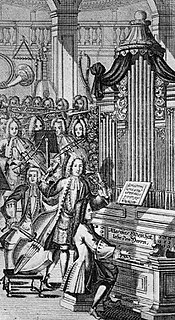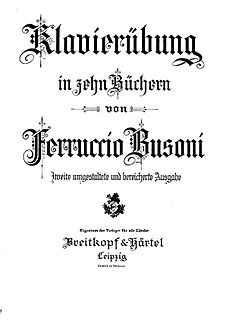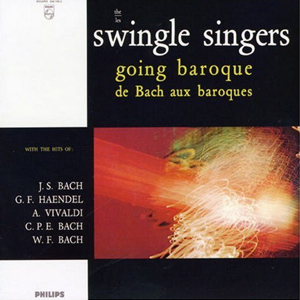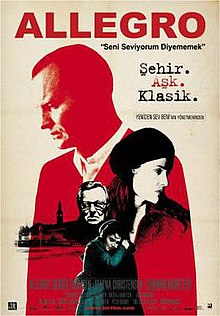The Bach-Werke-Verzeichnis is a catalogue of compositions by Johann Sebastian Bach. It was first published in 1950, edited by Wolfgang Schmieder. The catalogue's second edition appeared in 1990. An abbreviated version of that second edition, known as BWV2a, was published in 1998.
Karl Richter was a German conductor, choirmaster, organist, pianist and harpsichordist.
C minor is a minor scale based on C, consisting of the pitches C, D, E♭, F, G, A♭, and B♭. Its key signature consists of three flats. Its relative major is E♭ major and its parallel major is C major.
The Italian Concerto, BWV 971, originally titled Concerto nach Italienischen Gusto, is a three-movement concerto for two-manual harpsichord solo composed by Johann Sebastian Bach and published in 1735 as the first half of Clavier-Übung II. The Italian Concerto has become popular among Bach's keyboard works, and has been widely recorded both on the harpsichord and the piano.

The keyboard concertos, BWV 1052–1065, are concertos for harpsichord, strings and continuo by Johann Sebastian Bach. There are seven complete concertos for a single harpsichord, three concertos for two harpsichords, two concertos for three harpsichords, and one concerto for four harpsichords. Two other concertos include solo harpsichord parts: the concerto BWV 1044, which has solo parts for harpsichord, violin and flute, and Brandenburg Concerto No. 5 in D major, with the same scoring. In addition, there is a nine-bar concerto fragment for harpsichord which adds an oboe to the strings and continuo.
Tribute is a ballet made by Christopher d'Amboise to music by Johann Sebastian Bach. The première took place Saturday, June 4, 2005, at the School of American Ballet workshop performance, Juilliard Theater, Lincoln Center for the Performing Arts. The New York City Ballet première was Sunday, February 4, 2007, at the New York State Theater, also at Lincoln Center.
Christoffer Boe is a Danish film director and screenwriter. He is an established and well-known not only in Denmark, but all through the world. Among his international awards there are FIPRESCI Director of the Year at San Sebastián International Film Festival and Golden Camera at Cannes Film Festival in 2003. He is also co-founder and director of the film production company AlphaVille Pictures Copenhagen.

The Klavierübung, by the Italian pianist-composer Ferruccio Busoni, is a compilation of piano exercises and practice pieces, comprising transcriptions of works by other composers and original compositions of his own.

The Bach-Busoni Editions are a series of publications by the Italian pianist-composer Ferruccio Busoni (1866–1924) containing primarily piano transcriptions of keyboard music by Johann Sebastian Bach. They also include performance suggestions, practice exercises, musical analysis, an essay on the art of transcribing Bach's organ music for piano, an analysis of the fugue from Beethoven's 'Hammerklavier' sonata, and other related material. The later editions also include free adaptations and original compositions by Busoni which are based on the music of Bach.

Going Baroque is the second album released by the Paris-based Swingle Singers. The album was a 1964 Grammy award winner for "Best Performance by a Chorus."

Anyone for Mozart, Bach, Handel, Vivaldi? is a CD compilation re-issue of music by the Swingle Singers. It combines tracks from two previous LP releases, Going Baroque and Swinging Mozart.
The Bodil Award for Best Actor in a Leading Role is one of the merit categories presented annually by the Danish Film Critics Association at the Bodil Awards. Created in 1948, it is one of the oldest film awards in Europe, and it honours the best performance by an actor in a leading role in a Danish produced film. The jury can decide not to hand out the award. This has happened five times, in 1952, 1970, 1976, 1985, and in 1986.

The concerto for two harpsichords in C minor, BWV 1060, is a concerto for two harpsichords and string orchestra by Johann Sebastian Bach. It is likely to have originated in the second half of the 1730s as an arrangement of an earlier concerto, also in C minor, for oboe and violin. That conjectural original version of the concerto, which may have been composed in Bach's Köthen years (1717–1723), is lost, but has been reconstructed in several versions known as BWV 1060R.
The Robert Award for Best Actor in a Supporting Role is one of the merit awards presented by the Danish Film Academy at the annual Robert Awards ceremony. The award has been handed out since 1984.

The organ sonatas, BWV 525–530 by Johann Sebastian Bach are a collection of six sonatas in trio sonata form. Each of the sonatas has three movements, with three independent parts in the two manuals and obbligato pedal. The collection was put together in Leipzig in the late 1720s and contained reworkings of prior compositions by Bach from earlier cantatas, organ works and chamber music as well as some newly composed movements. The sixth sonata, BWV 530, is the only one for which all three movements were specially composed for the collection. When played on an organ, the second manual part is often played an octave lower on the keyboard with appropriate registration. Commentators have suggested that the collection might partly have been intended for private study to perfect organ technique, some pointing out that its compass allows it to be played on a pedal clavichord. The collection of sonatas is generally regarded as one of Bach's masterpieces for organ. The sonatas are also considered to be amongst his most difficult compositions for the instrument.

Jean-Maurice Mourat is a classical music guitarist, composer and former director of musical conservatories. He writes music for guitar, as well as for flute and piano. He has written a number of transcriptions for flute and guitar. His musical compositions are published by six French publishers and one Canadian publisher. He is also the author of a number of pedagogical works on guitar playing.

The Toccatas for Keyboard, BWV 910–916, are seven pieces for clavier written by Johann Sebastian Bach. Although the pieces were not originally organized into a collection by Bach himself, the pieces share many similarities, and are frequently grouped and performed together under a collective title.








